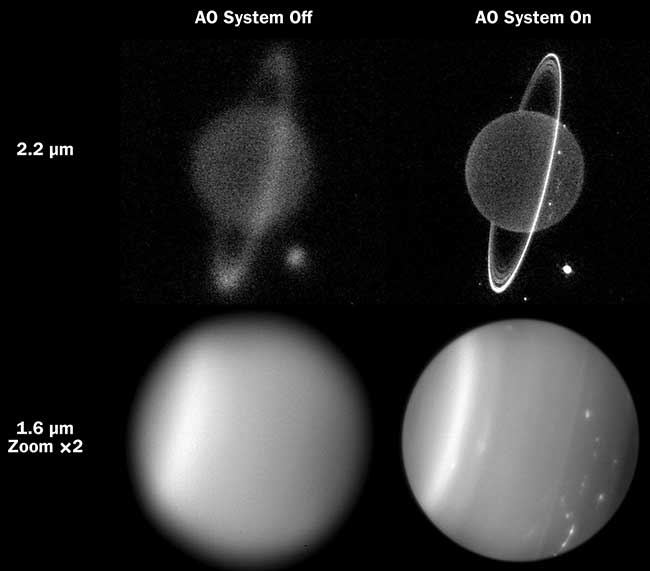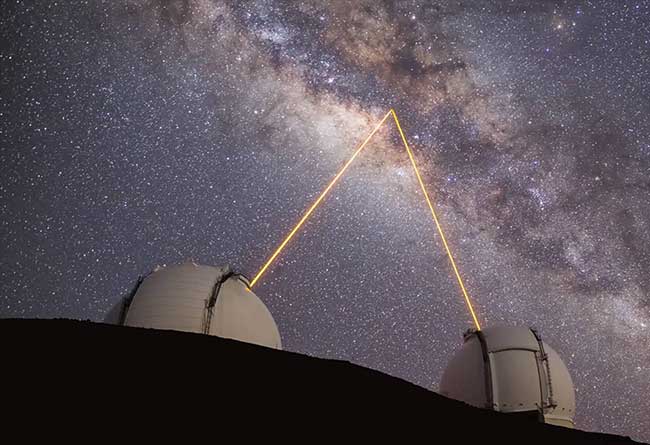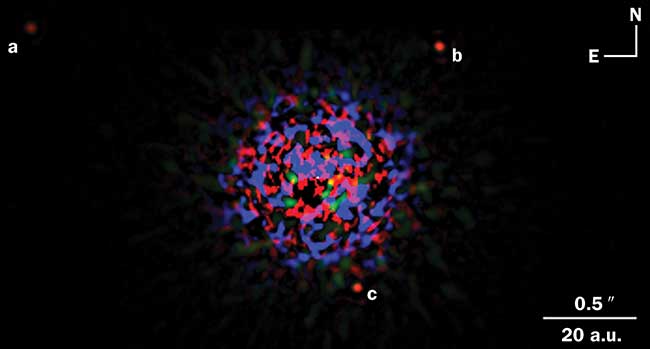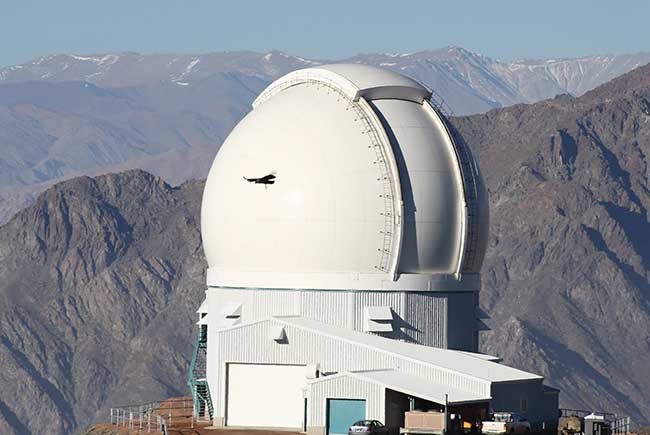Astronomy remains the biggest driver of advancing adaptive optics systems, but the technique is also gaining ground for ophthalmology and deep-tissue imaging.
Decades after the Cold War ended, technology developed for the U.S. Strategic Defense Initiative (“Star Wars”) missile defense program continues to be of use, emerging in fields ranging from space communication and exploration to brain imaging.
The first adaptive optics (AO) systems were developed in the early 1970s, driven by the desire of the U.S. and Soviet militaries to propagate effectively high-power, focused laser beams through atmospheric turbulence for missile defense and to obtain high-resolution images of each other’s surveillance satellites. Although many improvements have been made since then, the principles behind AO have not changed. Most of these systems still consist of three elements: the wavefront sensor, the deformable mirror (which dominates the cost of the system), and the reconstruction algorithm/processor.

IR images of the planet Uranus without adaptive optics (left) and with adaptive optics (right).
Observations at the W.M. Keck Observatory at two different wavelengths: 2.2 μm emphasizing the rings
of Uranus (top row) and 1.6 μm emphasizing cloud features (bottom row). Courtesy of Heidi Hammel and Imke de Pater; W.M. Keck Observatory.
By reducing the effect of wavefront distortions, adaptive technology improves the performance of optical systems. The goal is to correct the deformations of an incoming wavefront by deforming a mirror to compensate for the distortion.
Quick to recognize the clarifying power of AO was the astronomical community, which remains the biggest proponent and driver of new advances. The initial prototypes of astronomical AO appeared in the late 1980s; the first general-use AO facility became available on an astronomical telescope in 1990.
“In the last 20 years almost every large optical telescope — with aperture diameter larger than five meters — [came] equipped with some sort of AO compensation,” said Szymon Gladysz, Adaptive Optics Group leader at the Fraunhofer Institute of Optronics, System Technologies and Image Exploitation (IOSB) in Ettlingen, Germany. “The next generation of extremely large telescopes (ELTs) all featured AO in their design from the start.”
Compensating for disturbances
According to Claire E. Max, professor of astronomy and astrophysics and director of the University of California Observatories at the University of California, Santa Cruz, the most recent advances in astronomical AO lie in the area of ground-layer AO (GLAO). Depending on the conditions, atmospheric turbulence can vary with altitude, but studies have shown that the majority of atmospheric disturbance occurs in the ground layer of the atmosphere.
One example came to fruition in 2017 after more than a decade of planning, construction, and testing. The new Adaptive Optics Facility (AOF) was coupled to the instrument MUSE (Multi-Unit Spectroscopic Explorer) of the European Southern Observatory’s (ESO) Very Large Telescope (VLT) last year and has since provided views of planetary nebulae and galaxies at twice the spatial resolution previously achievable.
The AOF system comprises a 4 Laser Guide Star Facility (4LGSF) that shines four 22-W laser beams into the sky to make sodium atoms in the upper atmosphere glow, producing spots of light on the sky that mimic stars. Sensors in the AO module use these artificial guide stars to determine the atmospheric conditions.

Laser guide star adaptive optics (AO) has been a major boon to the study of the black hole at the center of the Milky Way. Laser guide star AO is used by both Keck Telescopes — one feeding the NIRC2 high-resolution IR camera and the other feeding the OSIRIS imaging spectrograph. Studies of stellar orbits by the Galactic Center Group at UCLA and at the Max Planck Institute for Extraterrestrial Physics have determined the mass of the central black hole to be about 4 million times the mass of the sun. Courtesy of Sean Goebel Photography and W.M. Keck Observatory.
With this information, the AOF system calculates the correction that must be applied to change the shape of the telescope’s deformable secondary mirror to compensate for atmospheric disturbances.
The addition of the AOF system is essentially equivalent to raising the VLT about 900 m higher in the air, above the most turbulent layer of atmosphere. MUSE is now able to observe the smallest, faintest galaxies at large distances at a fraction of the cost. Such galaxies that are still in the making are crucial to understanding how galaxies form.
“This is a method for achieving image improvement over a considerably larger field of view than previous methods, albeit with a lower quality of aberration,” Max said.
The next improvements to the system are expected to take place this year, which will narrow the field mode to correct for turbulence at any altitude, allowing observations of smaller fields of view to be made with even higher resolution.

In 2008, high-contrast adaptive optics observations with the Keck and Gemini telescopes revealed three planets (a, b, c) orbiting the star HR 8799 (center). Multiepoch data shows counterclockwise orbital motion for all three imaged planets. Subsequent observations have also discovered a fourth planet. Here, the image of the central star has been subtracted to a large degree, but some speckles remain. Courtesy of Christian Marois et al.; W.M. Keck Observatory.
ESO hopes its work on the AOF will equip it with the knowledge and expertise required to eventually apply AOF to its ELT, but Max highlights the hurdles that first need to be overcome.
“For astronomical AO, it will be challenging to implement ground-layer AO at the next generation of extremely large telescopes (TMT, GMT, E-ELT),” she said.
“These all require large adaptive secondary mirrors that will be ambitious to manufacture, support, and keep aligned. But if these GLAO systems meet expectations, they will result in significantly higher performance for the large, wide-field astronomical spectrographs of the future.”
Search for E.T. intelligence
For Franck Marchis, senior planetary astronomer and chair of the exoplanet group at the SETI Institute, the search for extraterrestrial intelligence is the most exciting application of advancing AO technology.

Adaptive optics technology is key to the team at SETI in the search for extraterrestrial intelligence. Courtesy of SETI.
Increased speed of the deformable mirror (DM) controller and a reduction in the latency, along with highly sensitive electron-multiplying CCD cameras, have allowed for AO loops to run at more than 1 kHz, Marchis said. That’s crucial for a lot of applications where the phase variations are quickly changing because of atmospheric variation.
“AO engines, or integrated AO systems with reliable WFS [wavefront sensors]/DM and easy-to-use software that are almost plug-and-play, are making AO mainstream,” Marchis said.
As easy-to-use AO systems become increasingly available — with products being sold by companies such as Alpao in France and Iris AO Inc. in Berkeley, Calif. — users are becoming more diverse and new projects are flourishing.
Examples include projects that involve the direct imaging of Earth-like exoplanets around Alpha Centauri, the closest star system to our solar system.
“Privately funded projects, like TIKI (mid-infrared), Project Blue (visible in space), and ELF (visible on the ground), which used AO coupled with coronagraphy, is probably the hot goal of our decade,” Marchis said. “If we discover signs of life on an exoplanet around the Alpha Centauri stars, that will be because of adaptive optics.”

Uranus as seen by the Hubble Space Telescope in infrared light (left). This is a false-color image, since our eyes cannot see infrared light. The blue regions indicate where the Uranus atmosphere is clear, allowing sunlight to penetrate deep into Uranus. The white and pinkish clouds along the bottom rim are high in the atmosphere and are bright because of reflected sunlight. An infrared composite image of Uranus obtained with Keck II Telescope adaptive optics (right). In this false-color image, displayed colors of blue, green, and red represent near-infrared wavelengths of 1.26, 1.62, and 2.1 µm, respectively. This roughly approximates the view that would be available to human vision if the response of the eye could be shifted to longer wavelengths beyond red (0.7 µm). Courtesy of Lawrence Smarovsky (U. Wisconsin) and W.M. Keck Observatory.
Project Blue aims to image Earth-like planets, which are roughly 0.5 to 1.5× the size of Earth, orbiting within either of Alpha Centauri’s habitable zones. If such a planet possessed an atmosphere that could allow liquid water to exist on its surface, the project may capture the first images of another blue planet.
A prototype compact space telescope with a 45- to 50-cm aperture is set to be built in 2018, with the aim of launching it in 2023. The instrument will be equipped with high-contrast imaging technologies embedded in a coronagraph with a deformable mirror, multistar wavefront control, and specialized postprocessing.
It is the coronagraph that will suppress the light from both stars Alpha Centauri A and B to reveal any orbiting planets, which can then be imaged thanks to the onboard AO.
The success or failure of privately funded projects such as Project Blue often comes down to cost. In particular, Marchis notes that the most expensive portion of an AO system is its deformable mirror.
“Reduction of cost of the AO systems, especially the DMs, is key to making this technology truly mainstream,” he said. “Mass production with new MEMS-based technologies, like 3D printing, could help.”
Bioimaging benefits from AO
Technical advances in AO technology developed for defense and astronomy were picked up by the biomedical community in the second half of the 1990s. In ophthalmology, AO was first applied to high-resolution retinal imaging in 1997, and the field of AO-assisted ophthalmology continues to thrive. The most recent and most advanced imaging modalities, such as optical coherence tomography (OCT), are being coupled with AO.
Voptica is a pioneering medical device company based in Murcia, Spain, that is using AO based on liquid crystal technology to characterize a patient’s eye in preparation for vision-correcting surgery.
Its VAO (visual adaptive optics) simulator analyzes wavefront aberrations to determine individual optic characteristics and then simulates any kind of corrections. These corrections can be applied separately or in different combinations to find the optimum adaptation for each patient.
According to Voptica co-founder Pablo Artal, the most significant recent advances in AO for the eye are the availability of liquid crystal spatial light modulators and more deformable mirrors at an affordable price. The combination of cheaper correcting devices and the implementation of deep-learning-based approaches for wavefront correction have enabled companies such as Voptica to bring its products to market.
Starting from the early 2000s, AO was applied to microscopy, and, according to Fraunhofer’s Gladysz, this area seems to be peaking right now.
“Examples include wavefront-shaping to overcome, or at least partly compensate for, scattering in the tissue, at focusing depths exceeding 1 mm, and AO in superresolution microscopy,” Gladysz said,
noting this peak has no doubt been boosted by the decreasing cost of deformable mirrors. “In the 1990s, cost of a deformable and its power supply was formidable, in excess of $1000 per actuator, but now the cost per actuator can be as low as $100.”
One prominent area interested in AO is brain imaging. Ideally, those performing brain imaging would like to accomplish transcranial imaging, leaving the skull intact.
In a method known as multipupil adaptive optics, researchers at Purdue University developed a specialized type of AO technology that can take high-resolution time-lapse images of functioning brain cells to shed light on how the brain works.
The method relies on deformable mirrors that change shape to counteract the distortion caused when light passes through biological tissue and a prism array containing many faceted segments1.
Each segment produces its own image corresponding to a different part of a microscope’s field of view. Since the approach enables different regions to be observed simultaneously, brain cells can be viewed over a wider field of view and at high resolution.
Researchers used the system to image brain cells called microglia; signaling processes of neurons involving calcium; vasculature in the brain; and dendritic spines, structures in neurons critical to learning and communication between brain cells.
Despite the reduction in price of some components within an AO system, cost remains one of the largest barriers to wider implementation in applications outside of astronomy.
“To realize cost reductions, we need to see an increased demand for applications requiring AO solutions that utilize a technology whose unit costs greatly reduce with volume,” said John Taranto of the Advanced System Technologies Group at Thorlabs Inc. “One such technology would be MEMs-based designs.”
But it’s not just manufacturing costs that pose a problem. When imaging below the tissue surface, optical aberrations are introduced, which are further complicated by the fact that biological tissue is highly scattering.
Another challenge is anisoplanatism, a phenomenon in which the effect of optical aberrations changes significantly across the field of view. This effect limits the field that can effectively be corrected in astronomy, retinal imaging, and microscopy.
“The only solution is the so-called multiconjugate AO, which is unfortunately very complex and expensive and currently resides in the domain of large-scale multinational projects spanning several years of R&D, for example, in astronomy,” Gladysz said. “It is not suitable for laboratory or clinical AO systems used in medicine, yet.”
Predicting when the challenges may be overcome for deep-tissue imaging is difficult to say. Developing a means to image deeper in scattering tissue becomes a balance between having a safe optical power density at the surface while achieving the necessary power density at depth to be able to detect optical return signals after the round-trip optical losses.
Reference
1. J.H. Park et al. (2017). Large-field-of-view imaging by multi-pupil adaptive optics. Nature Methods, Vol. 14, pp. 581-583. doi:10.1038/nmeth.4290.